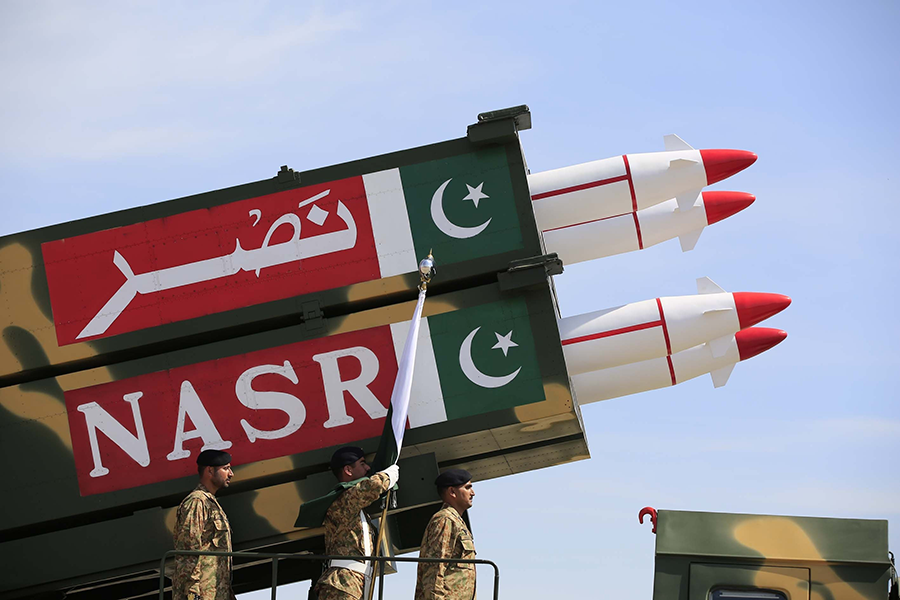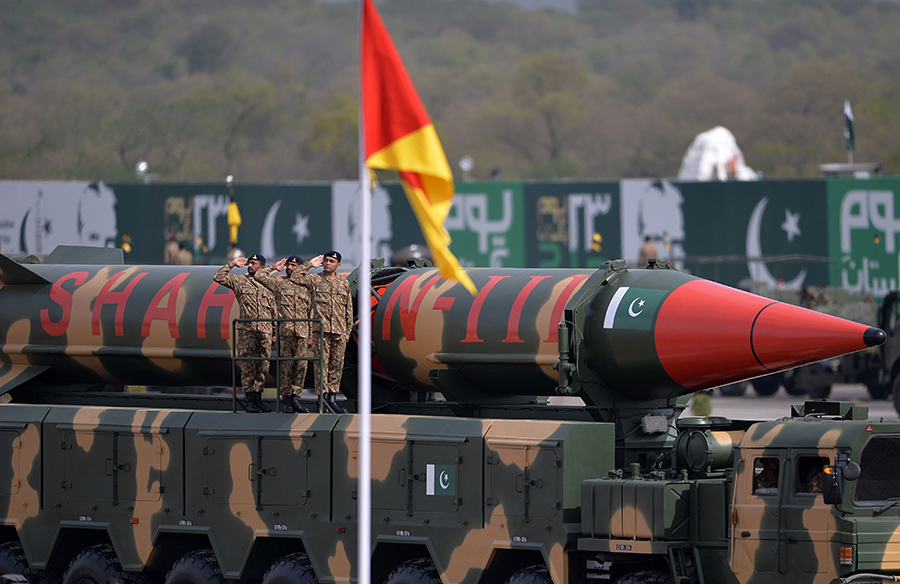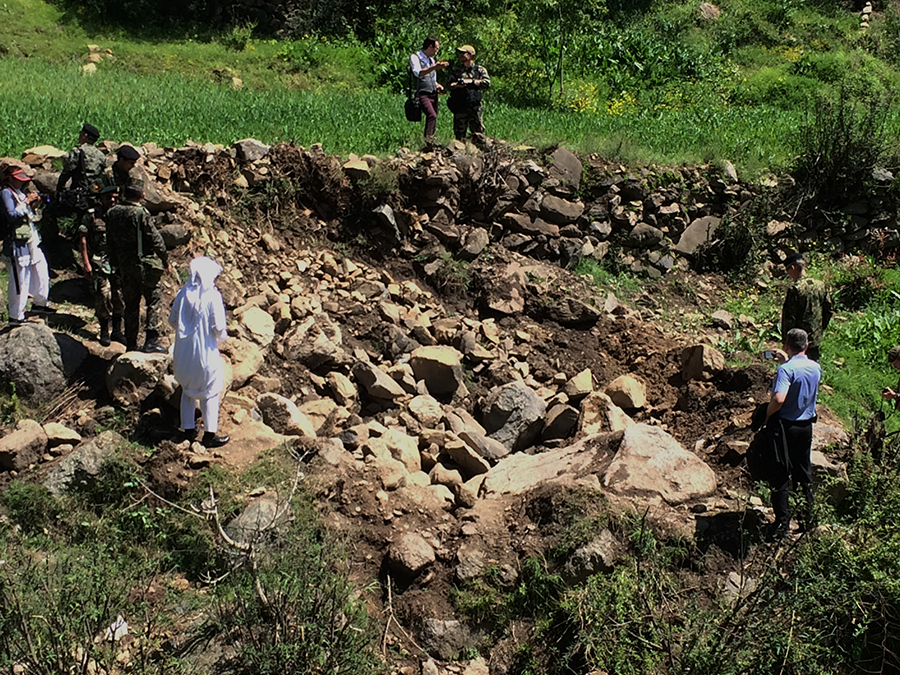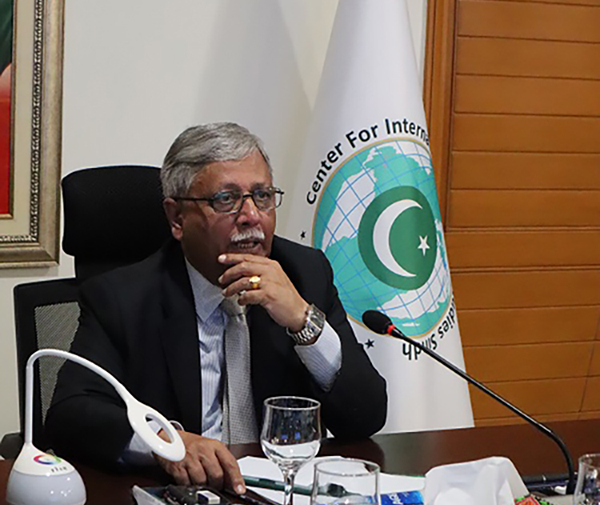"The Arms Control Association’s work is an important resource to legislators and policymakers when contemplating a new policy direction or decision."
Pakistan’s Evolving Nuclear Doctrine
October 2023
By Sitara Noor
In May, Pakistan commemorated the 25th anniversary of nuclear tests that were carried out in response to a series of nuclear blasts conducted by India a few weeks earlier.
 Islamabad’s decision to pursue a nuclear weapons program was largely shaped by its 1971 war with New Delhi, which led to the dismemberment of the country, and India’s first nuclear test, in May 1974. Faced with an escalating conventional imbalance vis-à-vis India, Pakistan saw nuclear deterrence as the primary means to establish strategic stability and dissuade India from engaging in a major future conflict. Since then, Pakistan has been trying to come up with solutions to what it deems destabilizing moves by India in the conventional and nuclear domains.
Islamabad’s decision to pursue a nuclear weapons program was largely shaped by its 1971 war with New Delhi, which led to the dismemberment of the country, and India’s first nuclear test, in May 1974. Faced with an escalating conventional imbalance vis-à-vis India, Pakistan saw nuclear deterrence as the primary means to establish strategic stability and dissuade India from engaging in a major future conflict. Since then, Pakistan has been trying to come up with solutions to what it deems destabilizing moves by India in the conventional and nuclear domains.
Although India publicly enunciated its nuclear doctrine in 2003, Pakistan, preferring ambiguity, did not make its doctrine public. Instead, it issued statements through various official channels from time to time to provide some insight into its nuclear policy. The deliberate ambiguity served Pakistan well and has allowed the country more flexibility to adjust its policy as India continued to evolve its conventional and nuclear posture.
The conception of Pakistan’s officially undeclared nuclear doctrine rests on formal statements from the civil and military leadership. This includes statements from the prime minister; press releases by the Inter Services Public Relations (ISPR), the media wing of the Pakistani military; and statements from other officials such as the foreign minister and Lt. Gen. Khalid Ahmed Kidwai, the founder and longtime director-general of the Strategic Plans Division.
Kidwai, in particular, regularly articulated policy positions in interviews and speeches in numerous national and international platforms while serving as the director-general of the Strategic Plans Division and, after retirement, as an adviser to the National Command Authority, the apex decision-making body that deals with all policy matters concerning nuclear weapons.
During a recent address at an event commemorating the nuclear test anniversary, Kidwai provided additional insights into Pakistani nuclear doctrine. Given his pivotal role in shaping this doctrine, his statements continue
to carry significant influence even in retirement and have ignited debate regarding potential shifts in the
country’s nuclear stance.
To understand the comments and their significance and potential impact on future policy, it is crucial to situate Kidwai’s speech within the broader context of Pakistani nuclear doctrine as it underwent various adaptations and alterations in response to changing regional dynamics and policies in India over the past two decades.
Enduring Features of the Doctrine
In contrast to India’s declared no-first-use nuclear policy, Pakistan decided not to endorse such a policy, thus leaving open the interpretation that Islamabad might use nuclear weapons first under certain circumstances. This has been a consistent, long-standing feature of the country’s nuclear posture. Given that the Pakistani nuclear arsenal serves as a deterrent against conventional aggression and nuclear threats from India, Islamabad deems it appropriate to maintain the first-use option. This is even more important for the country’s security because India’s no-first-use policy has been significantly diluted in recent years, as indicated by various official Indian statements.1
Unlike the Cold War practice, Pakistan views its nuclear weapons as an instrument of deterrence, and it is not seeking to obliterate the adversary in a splendid first strike or a bolt-from-the-blue-type attack. In that regard, Pakistan reportedly has kept its weapons in a de-mated form, meaning the warhead is separated from the delivery vehicle, with a strict centralized command-and-control system in place. Following the first successful flight test in 2011 of Nasr, also known as the Hatf-9, a solid-fueled tactical ballistic missile with a range of 60 kilometers, there were apprehensions regarding potential command-and-control challenges associated with its deployment. Nevertheless, Pakistan has maintained its position and reaffirmed assurances that it will continue to assert a centralized command and control over all missiles. This stance has remained consistent even after India’s advancements in the development of canisterized nuclear missiles.
Another enduring feature of Pakistani nuclear policy is a unilateral moratorium on nuclear testing underscored by Islamabad’s declaration that “it was not the first country to test and will not be the first to resume testing of nuclear weapons in South Asia.”2 Pakistan even offered to convert its unilateral moratorium into a bilateral commitment with India as a confidence-building measure. Nonetheless, India has not accepted this proposal, and there are signs that India may undertake another series of nuclear tests. Pakistan’s moratorium is subject to India’s decision in that regard. If India decides to resume nuclear testing at some stage, Pakistan is likely to follow suit.
Pakistan’s nuclear weapons and deterrence posture is defensive and India specific, unlike India, which has kept its policy more open-ended and avoided identifying specific potential adversaries in its doctrine. This foundational element of Pakistan’s nuclear posture has been highlighted officially since its nuclear tests in 1998. While speaking at the UN General Assembly in September of that year, just a few months after the nuclear tests, Pakistani Prime Minister Nawaz Sharif unequivocally stated that “Pakistan’s nuclear tests were conducted not to challenge the existing non-proliferation regime, nor to fulfill any great power ambition. They were designed to prevent the threat or use of force against Pakistan. Our tests in response to India thus served the cause of peace and stability in our region.”3
Following the 2011 U.S. military operation that killed al Qaeda leader Osama bin Laden in Pakistan, a discussion erupted over whether Pakistan might reevaluate its nuclear strategy to deter potential threats from its western border other than India. A similar argument has surfaced periodically suggesting Israel as a potential adversary for Pakistan. This argument gathered strength in view of the fact that Pakistan has no diplomatic relations with Israel and consistently takes a firm stance in support of the Palestinian cause against Israel in international forums. Likewise, the close defense ties between India and Israel, as well as Israel's alleged collaboration with India on potential air strikes against the nascent Pakistani nuclear program in the 1980s, contributed to this heightened sense of threat perception between the two countries.
This debate gained more traction with the testing in 2015 of Pakistan’s first intermediate-range ballistic missile, the two-stage, solid-fueled Shaheen III, having a range of 2,750 kilometers. Although Pakistan’s declared intent in developing the missile was to cover the entire Indian landmass including the Andaman and Nicobar Islands,4 there were concerns, particularly in the United States, about the Shaheen III potentially having the capacity to reach other targets, such as Israel. This debate resurfaces every now and then, but there has never been an official statement or any other indication of a shift to identify Israel as a potential target. On the contrary, Pakistan repeatedly has reiterated that its nuclear weapons program is only to deter threats from India. Likewise, the range of the Shaheen III was capped intentionally at 2,750 kilometers to allay any such concerns.
Evolving Trends
Pakistan started its nuclear program as a counter to India’s conventional superiority, particularly after losing its eastern territory in the 1971 war with India. Therefore, Pakistan’s nuclear policy has been inherently reactionary. As India’s nuclear and conventional posture changed over the years, so did Pakistan’s response, with some key inflection points being the 1998 nuclear tests and the development in the 1990s of a robust nuclear delivery infrastructure, including the Ghaznavi, Ghauri, and Shaheen missile systems, in response to India’s development of the Prithvi and Agni strategic missile series.
 Along the way, Pakistan has maintained a deliberate ambiguity about the size of its arsenal, its targeting options, and the thresholds for nuclear use. All these elements have evolved over the years in response to the evolving threat perception from India.
Along the way, Pakistan has maintained a deliberate ambiguity about the size of its arsenal, its targeting options, and the thresholds for nuclear use. All these elements have evolved over the years in response to the evolving threat perception from India.
Credible minimum deterrence is another early tenet of Pakistan’s nuclear doctrine as laid out in various official statements. On May 20, 1999, a year after the nuclear tests, Sharif stated that, “in maintaining the nuclear deterrence, we remain acutely conscious of the risks and responsibilities arising from the possession of nuclear weapons.... Nuclear restraint, stabilization and minimum credible deterrence constitute the basic elements of Pakistan’s nuclear policy.”5 Further explaining the rationale and dynamism of this tenet, one Pakistani official maintained that “minimum cannot be quantified in static numbers. The Indian buildup will necessitate review and reassessment.”6
This inherent flexibility in Pakistan’s credible minimum deterrence posture has enabled the country to respond to shifts in India’s nuclear and conventional strategies. In light of India’s evolving Cold Start doctrine, which envisages a swift military action against Pakistan under the nuclear overhang, meaning trying to find an opportunity to attack Pakistan despite the threat of nuclear escalation, Islamabad transitioned toward what it called a “full spectrum deterrence” approach. Notably, Pakistan consistently has asserted its commitment to the fundamental principle of maintaining a credible minimum deterrence while resorting to full-spectrum deterrence. This shift toward full-spectrum deterrence was announced in 2011 in a press release after Pakistan’s first test of the Nasr tactical nuclear weapon.7 Expanding on this concept, Kidwai has asserted that, with a “full spectrum of nuclear weapons in all three categories—strategic, operational and tactical—[and] with full range coverage of the large Indian land mass and its outlying territories…[India would have] no place to hide.”8
More recently, Kidwai provided additional details on full-spectrum deterrence. Speaking at the Institute of Strategic Studies in Islamabad on May 24, he stated,
Pakistan’s full-spectrum deterrence capability, while remaining within the larger philosophy of credible minimum deterrence, comprises horizontally of a robust tri-services inventory of a variety of nuclear weapons…[that] is held on land with the Army Strategic Forces Command, the ASFC; at sea with the Naval Strategic Forces Command, the NSFC; and in the air with the Air Force Strategic Command, the AFSC. Vertically, the spectrum encapsulates adequate range coverage from zero meters to 2,750 kilometers, as well as nuclear weapons destructive yields at three tiers: strategic, operational, and tactical. India’s vast eastern and southern geographical dimensions are, therefore, entirely covered.… Pakistan possesses an entire range of weapons yield coverage in terms of kilotons…and the numbers strongly secured to deter the adversary’s declared policy of massive retaliation…. Pakistan retains the liberty of choosing from a full spectrum of targets in a target-rich India, notwithstanding the Indian indigenous ballistic missile defense capability or the Russian S-400, to include countervalue, counterforce, and battlefield targets.9
The statement offers insights into Pakistan’s evolving nuclear posture, highlighting recent developments, reiterating previously outlined features of the full-spectrum deterrence concept, and shedding light on potential future trends.
 Kidwai’s statement about “range coverage from zero meters to 2,750 kilometers” has piqued greater curiosity. Several national and international scholars have weighed in on the risks involved in adopting such a policy.10 Following the mounting debate over the logic of a range of zero meters, a clarification came in a tweet from a government-sponsored think tank. The tweet quoted Kidwai as saying that the reference to zero meters in his speech was just “metaphorical” and there was no change in the Pakistani missile ranges. The clarification indicates that toying with the idea of a range of zero, whether metaphorically or otherwise, may not directly reflect the official stance of the Strategic Plans Division or the National Command Authority. It implies, however, that such considerations may have existed to some degree in the periphery. Therefore, it is important to discuss the merits of any such policy that might have been under consideration at any level.
Kidwai’s statement about “range coverage from zero meters to 2,750 kilometers” has piqued greater curiosity. Several national and international scholars have weighed in on the risks involved in adopting such a policy.10 Following the mounting debate over the logic of a range of zero meters, a clarification came in a tweet from a government-sponsored think tank. The tweet quoted Kidwai as saying that the reference to zero meters in his speech was just “metaphorical” and there was no change in the Pakistani missile ranges. The clarification indicates that toying with the idea of a range of zero, whether metaphorically or otherwise, may not directly reflect the official stance of the Strategic Plans Division or the National Command Authority. It implies, however, that such considerations may have existed to some degree in the periphery. Therefore, it is important to discuss the merits of any such policy that might have been under consideration at any level.
Kidwai’s clarification reiterates that there is no change in the range of nuclear missiles and the existing range of missiles from 60 kilometers to 2,750 kilometers shall remain sacrosanct for now. Nonetheless, it reinforces speculation that any potential change in the range, if at all, will amount to a change in the type of weapons system employed, for example, resorting to nuclear artillery or nuclear land mines.
 Thoughts about resorting to lower-range weapons appears to be influenced by the growing belief in New Delhi that India’s 2019 airstrikes on Balakot, triggered by an alleged Pakistani-backed suicide attack on Indian forces in Pulwama, exposed a gap in Pakistan’s full-spectrum deterrence posture. With a lower range, Pakistan seems intent on plugging that perceived gap by lowering the nuclear threshold.
Thoughts about resorting to lower-range weapons appears to be influenced by the growing belief in New Delhi that India’s 2019 airstrikes on Balakot, triggered by an alleged Pakistani-backed suicide attack on Indian forces in Pulwama, exposed a gap in Pakistan’s full-spectrum deterrence posture. With a lower range, Pakistan seems intent on plugging that perceived gap by lowering the nuclear threshold.
Regardless of the weapons system or range, any potential policy shift must weigh carefully the challenges and costs associated with it against the intended benefits. Especially in the nuclear policy domain, any shift should target specific strategic objectives rather than tactical advantages. Advocating a reduction in the nuclear threshold likely will lead to the latter, potentially overlooking the broader strategic costs associated with such a move.
A robust nuclear deterrence rests on the ability of the state to communicate the threat effectively while demonstrating the capability and resolve to carry out the threat. For deterrence to be effective, it is crucial for it to function within a specific operational range. If the nuclear threat surpasses a certain upper threshold, it could be perceived as implausible and consequently lose its effectiveness. Conversely, lowering the threshold too much carries the risk that the adversary might opt to absorb a low-yield attack and ultimately prevail on the political and diplomatic fronts. The essence of deterrence lies in the notion of inflicting unacceptable damage. If the threshold and yield are reduced to a point where the nuclear damage becomes tolerable or acceptable for the adversary, especially when weighed against potential nonkinetic political and diplomatic costs it may inflict on the adversary, the efficacy of deterrence could be compromised.
Notwithstanding the safety, security, and command-and-control challenges, the potential use of low-yield, shorter-range nuclear weapons with the aim to stop the Indians in their tracks may halt temporarily their advancement, but it is less likely to produce a major military advantage for Pakistan. On the contrary, it could be a diplomatic nightmare because it may open the floodgates of international condemnation for breaking the much-revered nuclear taboo.
Such a posture also goes against the primary concept of Pakistan’s nuclear deterrence, which views nuclear weapons as weapons of last resort that would inflict unacceptable damage on the enemy. The potential use of lower-yield nuclear weapons is neither the last resort nor potentially the cause of an infliction of unacceptable damage to the adversary, but as a first response, no matter how limited in yield, this approach would be enough to allow India to justify its massive retaliation response.
The potential change in the range also must be seen in the context of other elements of Kidwai’s speech. Another significant point was his reiteration of the importance of a full spectrum of targets, which include countervalue targets such as cities and civilian population centers and counterforce targets, including conventional and nuclear military targets, their associated infrastructure, and other logistics.
Pronouncements about a spectrum of targets and an emphasis on “countermassive retaliation” have been articulated in previous addresses,11 but their reiteration in conjunction with proposals to lower the nuclear threshold indicates a major shift from deterrence by punishment to deterrence by denial. This element has been duly noted by scholars who have highlighted that such an explanation of full-spectrum deterrence stands in sharp contradiction to the concept of credible minimum deterrence, which is a primary pillar of Pakistan’s declaratory nuclear policy.12 Likewise, there has to be convergence in the declaratory doctrine and its operationalization, otherwise deterrence could lose its credibility.13
Strengthening Deterrence
Since 2001-2002, India has worked simultaneously on two fronts. Diplomatically, it has pressured Pakistan with allegations about sponsoring terrorism in India and used this strategy as a pretext for avoiding bilateral talks to resolve issues with Pakistan. In contrast, Pakistan has struggled to garner international support on terrorism charges against India. Second, India is consistently advancing its conventional force posture with the aim of finding a way to attack Pakistan under the nuclear overhang. In addition to advancing its doctrine of limited conflict, India is transitioning gradually toward a nuclear war-fighting posture and contemplating preemptive counterforce first strikes against Pakistan.
Pakistan’s full-spectrum deterrence concept effectively has countered India’s plan to launch swift ingress into Pakistan under the Cold Start, or proactive, doctrine. Nevertheless, India’s purported surgical strikes in the wake of the Pulwama attack in February 2019 marked the first aerial skirmish between the two countries since their overt nuclearization. Following the Pulwama/Balakot crisis, in which Pakistan successfully responded to the Indian aerial aggression, both countries seem to have drawn contradictory lessons. From the Indian perspective, India has found a way to attack Pakistan under the nuclear overhang. Conversely, the Pakistanis believe their effective response has thwarted the perceived vulnerabilities that India sought to leverage.
The 2019 aerial exchange between the two nuclear-armed states underscored the importance of differentiating between theater-tactical-level deterrence and strategic deterrence. It also highlights the significance of conventional deterrence at the first rung of the escalation.14 Pakistan’s successful response in 2019 has proven that its conventional first response is effective, despite perceived weaknesses if it had to be employed in a long-drawn conventional war.
Therefore, in order to strengthen tactical-theater deterrence in an evolving strategic environment, Pakistan needs to further enhance its conventional strength. This will not only add strength to Pakistan’s nuclear deterrence posture, but would also be in line with Islamabad’s policy position of having “seamless integration between nuclear strategy and conventional military strategy” and using nuclear weapons as weapons of
last resort.15
ENDNOTES
1. Toby Dalton, “Much Ado About India’s No-First-Use Nuke Policy,” India Global Business, September 26, 2019, https://www.indiaglobalbusiness.com/igb-archive/much-ado-about-indias-no-first-use-nuke-policy.
2. Pakistani Ministry of Foreign Affairs, “Pakistan’s Policies on Arms Control, Non-Proliferation and Disarmament Issues,” n.d., https://mofa.gov.pk/acdis/ (accessed September 22, 2023).
3. “Text of Prime Minister Nawaz Sharif’s Speech at the UN: September 23, 1998,” Strategic Studies, Vol. 19/20 (1998).
4. “A Conversation With Gen. Khalid Kidwai,” Carnegie Endowment for International Peace, March 23, 2015, https://carnegieendowment.org/files/03-230315carnegieKIDWAI.pdf (transcript).
5. See Rodney W. Jones, “Minimum Nuclear Deterrence Postures in South Asia: An Overview,” U.S. Defense Threat Reduction Agency, October 1, 2001, n.39, https://www.globalsecurity.org/wmd/library/report/2001/south_asia.pdf.
6. Disarmament Diplomacy, No. 41 (November 1999) (quoting Pakistani Foreign Minister Abdus Sattar, November 25, 1999).
7. Inter-Service Public Relations, No. PR-94/2011-ISPR, April 19, 2011, https://www.ispr.gov.pk/press-release-detail.php?id=1721.
8. Khalid Kidwai, Address at “Defence, Deterrence and Stability in South Asia” workshop, Islamabad, December 13, 2016 (hereinafter 2016 Kidwai address).
9. Institute of Strategic Studies Islamabad, “Special Message by Lt. Gen. (Retd) Khalid Kidwai,” YouTube, May 25, 2023, https://www.youtube.com/watch?v=c3oOXOk3G1k.
10. For a detailed discussion on Pakistan’s evolving nuclear policy, see Ejaz Haider, “Nuclear Deterrence: Is the Last Resort the First Response?” The Friday Times, June 17, 2023; Adil Sultan, “The Next Decade of Nuclear Learning,” StrafAsia, May 28, 2023; Sitara Noor, “Did Pakistan Just Overhaul Its Nuclear Doctrine?” Foreign Policy, June 19, 2023, https://foreignpolicy.com/2023/06/19/pakistan-india-nuclear-weapons-zero-range-cold-start
-doctrine/.
12. Haider, “Nuclear Deterrence.”
13. Ali Ahmed, “Limiting a Subcontinental Nuclear War,” SP’s Land Forces, Vol. 11, No. 4 (August-September 2014), https://www.spslandforces.com/story/?id=317.
14. Syed Ali Zia Jaffery, “Enhancing Deterrence Stability on the Subcontinent: The Case for Conventional Deterrence,” Henry L. Stimson Center Visiting Fellow Policy Memo, April 8, 2020, https://www.stimson.org/2020/enhancing-deterrence-stability-on-the-subcontinent-the-case-for-conventional-deterrence/.
15. Khalid Kidwai, Keynote address and discussion session at “South Asian Strategic Stability: Deterrence, Nuclear Weapons and Arms Control” workshop, February 6, 2020, https://www.iiss.org/globalassets/media-library---content--migration/files/events/2020/transcript-of-lt-general-kidwais-keynote-address-as-delivered---iiss-ciss-workshop-6feb20.pdf.
